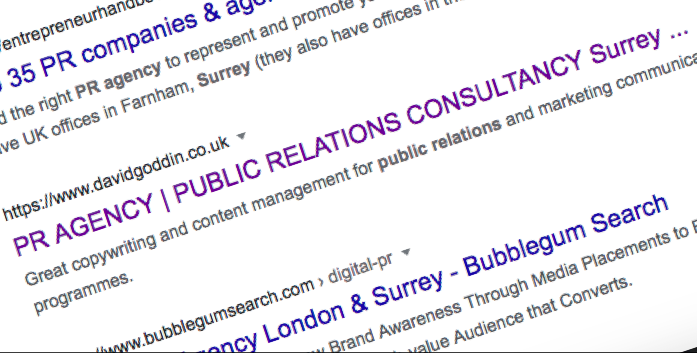Our Blog...
Think before you shoot – advice for better business videos
|
Thinking of video to support a public relations or marketing communications campaign? Great idea – but before you get carried away with the vast potential of production tools and techniques, think carefully.
Be clear on the results you want to achieve. Most likely you want to stimulate ‘buy’ decisions or similar reactions from the public. You will need video that is suitably attention-grabbing and can be accessed via online channels – social media and websites – as well as in-store displays or exhibition stands. Focus on a few key messages to include, produce appropriate video footage, add voiceovers and edit together to make a short programme. Keep it brief and to the point, to increase ‘hits’ on passers-by. Don’t confuse ‘promotional’ with ‘training’. I saw a new promotional video this week. As an attempt to get a message across, I thought, it was not too bad – but I think it could have had more impact at half its length. I felt it ticked the ‘we’ve got a video’ box, but I wonder if it will inspire any viewers. I discovered the video through a mention and link on a third-party website – nothing wrong with that, providing it’s also promoted on the organisation’s own website. Which it wasn’t. Nor was there any mention in the organisation’s social media accounts to drive traffic towards it. People normally don’t ‘just find’ promo videos. Another failing in the video was the lack of key direct calls to action – such as ’contact us’, ‘bookmark our website’ or ‘follow us on social media’. People won’t usually do things unless instructed. We all suffer from the brevity of touchpoints, especially online. To compensate, we need to make videos – and other online messages – to-the-point and as effective as possible. I’m unsure how the success (if any) of this week’s video will be assessed. Like any other communication project a corporate or marketing video needs:
Video is a great medium, and these days if you have a good mobile phone you are well on the way towards producing and editing material that is near-professional in content and quality. That’s the least you need if you are putting time and money into a project intended to influence public opinion or encourage them to take action. Better still: hire professionals. Published 17 June 2022 |
How to make your business heard on social media
|
I spend probably too much time on social media – but as a communication professional I am interested to see how people and organisations make use of the popular platforms to share information and build relationships.
The various channels have loads of great material, much of which undoubtedly boosts corporate image – as well as the bottom line. But, unfortunately, there is also a lot of content that is hardly worth a second look and definitely does not warrant long-term interest. Where is your business on the social media ladder? Do you see it as an essential business tool or an unnecessary add-on? Here are some simple guidelines to get more from your social media – to draw people to your website and to encourage them to buy from you.
Don’t be afraid to update and republish ‘old’ material – if it’s generally still relevant, it might trigger a surge of new business! Published 11 May 2022 |
Can internal public relations get any worse?
|
Hats off to UK ferry operator P&O Ferries for achieving what must surely be one of the worst-ever examples of bad internal public relations.
Yesterday’s surprise sacking of 800 crew members certainly does not count as communication because there was no immediate feedback loop. Worse still, it was apparently a complete bolt from the blue, with no prior discussion involving crews, unions or government. No surprise, then, that there is widespread anger against P&O and its Gulf-based owners – and sympathy for its displaced employees. News reports do not put P&O in a good light. The story broke yesterday when P&O’s vessels were turned back to port ahead of a ‘company announcement’. Back at the quayside, crew members were informed via a brief, one-way video call, that they were immediately redundant and would be replaced immediately by cheaper agency workers. No tact, no discussion and no attempt to soften the blow. To be fair, it must have been financially difficult to maintain a ferry service and keep vital trade routes open during the past two years of covid-19 and its associated lockdowns. But it was the crews who kept the service afloat – the same crews that are now grounded. In years gone by, P&O was one of the UK’s most prominent and respected shipping lines. This week’s episode is an insult to that heritage. The immediate take-home from this unusual incident is the importance of every company having a crisis communication plan that allows for the breaking of bad news with appropriate sensitivity to the feelings of all those involved. Better still, that there is proper consultation with stakeholders before the event. The secondary take-home is that while video conferencing is a very convenient, efficient and economical means of communicating – especially with large, geographically separated audiences – it is not necessarily the best way to convey bad tidings. Published 18 March 2022
|
Communication vital for post-covid business recovery
|
What’s your plan for 2022 – more of the same … or a bold new approach to business?
The past two years have been tough across the board in commerce and industry in the UK and other countries. Many doors have closed for the last time: others could follow if they do not adapt sufficiently to meet the challenges of the post-pandemic economy. It is fortunate that online shopping and related logistics had developed sufficiently before the pandemic to provide an economic lifeline while the world reeled under the pressures of the covid-19 crisis. When the world returns to ‘normal’ business activity, our high streets, office parks and industrial areas will, I am sure, be much busier than today. On the other hand, our patterns of work and shopping will undoubtedly retain some of the advantages of home-working and online business models. Most business people should understand the threats and opportunities that change can bring: the challenge is to minimise the impact of the former and maximise the benefits of the latter. Good communication will, I believe, be even more important for business survival and growth. Businesses that are truly successful will be those that communicate well – in terms of both quantity and quality of public relations activity. Quantity of published material is important because of the vast and growing volumes of information on the internet and social media. The greater the frequency of posts, the better chance of being seen. Quality of content – choice of subject matter, use of language and search engine optimisation tactics – enhances online visibility and boosts credibility. Content is often a stumbling block for businesses, but in reality there is plenty of potential in news about relevant people, products, applications, market trends, prices, ideas, guidelines and so on. People like me are in business to help companies communicate effectively, enhancing their reputations in the process. As consultants, we are ideally placed to provide objective advice and create appropriate content We thrive on developing ideas into powerful messaging designed to reinforce positive perceptions of our clients, leading to informed purchasing decisions. To be honest, there can be many other variables at play, so things don’t always work out as planned. But there’s nothing wrong with laying the foundations today for a sale at some future date. It’s sometimes said that every marketing piece should include a call to action: so if you’d like to find out more about a fresh communication campaign for your business, please get in touch. Published 14 December 2021
|
Dear Future Client – a message with wider benefit, too
|
As yet, I am not your consultant – so please forgive me if I am speaking out of turn. But I do follow your business on Twitter and have noticed aspects of your online presence that – were you my client – I would strongly advocate reviewing.
For example: Who do you follow? You are not following many other accounts, and some on your list are clearly irrelevant to your business. Concentrate on accounts that could be genuine sources of valuable information or channels towards your ideal customers. If you follow too many accounts, you will probably miss important posts from some that might matter. If you must Too few followers You don’t appear to have many followers. This means that you won’t get much reaction – if any – when you post something of value. You can’t make people follow your account, but you should promote it at every opportunity – on your website, your printed material and so on. Too few posts I know it takes time and creativity to draft good posts, but it is important to keep up the momentum. The Twitter stream provides the briefest of touchpoints with your followers, so if you are serious about being read, you must should post as often as you can. No quality content The information you provide should always be valuable to readers, especially those you want to acquire – and keep – as customers. It needs to answer questions and stimulate action – especially drivng traffic to your website. No calls to action Get people to do something. You should always include a link to the relevant section of your website. Use a link shortener such as bitly.com to avoid taking up too much space in a brief post, such as a Tweet. For example, https://bit.ly/2MYqZuP will take you straight to my contact form. No visible interaction Remember that Twitter and similar channels are classed as social media. Raise your head above the parapet and start interacting with people. Be sociable! Become known as a provider of valuable comment – and solutions. If you see something interesting online, like it, share it with your followers, or add a public comment. Like many in businesses similar to yours, you are probably thinking that you cannot afford the time or the expense of these suggestions. But the truth is that you cannot afford not to use social media channels to communicate with your target markets. Remember, it’s not just about sending messages, it’s also about receiving them. Please let me know when we might discuss this in more detail and how I could help you to communicate more effectively with your target market. Published 9 December 2021
|
Three 'c-words' that underpin business success
|
Every successful business is based on a great commercial idea – but turning the concept into reality involves three other important factors: communication, capital and customers.
Economic history is littered with potentially great ideas that failed because one or more of the c-words was lacking. I’ve listed communication first – partly because it is my business, but more as it is key to attracting both capital and customers. Great ideas flounder if there is inadequate backing. If I was blessed with an inventive mind and an entrepreneurial spirit – in addition to my communication experience – I’d take my idea to the public in this way:
Many basically good business ideas fall short of expectations as a result of inadequate communication – especially ‘news’ that is stale or uninteresting. There is really no excuse for this, given the ease with which we can use the internet, social media and email. But merely ‘being there’ is not enough. Online communication requires effort to maintain a presence and to interact with others – especially investors, influencers and potential customers. These days it’s easy to form a judgment about a business – yours and mine included – simply by looking at its website and social media presence. Top marks if a site’s content has changed since your last visit, and social media posts look frequent and fresh (Note to self…!). Published 7 December 2021
|
Website underperforming? Try this recipe
|
Starting to have second thoughts about a website that’s not pulling in the business you expected?
So what’s wrong with it? Perhaps one or more of the following:
Like many other entrepreneurs, you may already have spent much more on the project than you bargained for – but your online presence still does not seem to be pulling in the customers. You are simply failing to influence the right people – those who might be willing to buy what you are selling. Let’s assume that you have genuinely saleable products or services, competitively priced, of a good standard and potential ’must haves’ for a fair-sized market. If your website isn’t helping to move the goods, start by checking where you appear in Google’s organic rankings for a selection of appropriate search terms*. If you are not on the first one or two search results pages, you need either to make some serious improvements to your description and keywords or splash out on a paid-for listing**. Better still, call in a search engine optimisation (SEO) consultant to help. Second step is to ensure your website is easy on the eye – and on the click-finger. It must be visually appealing to new and returning visitors, confidently leading them to where you want them to make ‘buy’ decisions – and encourage them to do so. Third step is to ensure a stream of fresh and updated content so there’s always something new for returning customers – as well as Google’s algorithms. Get rid of outdated material, refresh ‘standing’ content. Old copy bores frequent visitors – and Google! Fourth step, and arguably the most important, is to promote the refreshed site – not once, but often – via social media. Create a need in readers’ minds and provide the solution on your site. People don’t randomly visit this site, but like you, they may respond to social media suggestions. Of course, in whatever our chosen field, larger competitors have the advantage of being able to invest more time and money in their websites and social media activity. But smaller competitors – you and me, for example – are often potentially more nimble, responsive and creative in addressing customers’ needs. And if we have the benefit of in-house content management skills, we can easily tweak our websites immediately and test fresh ideas. If you are unhappy with your website’s performance, change it – NOW! *For my website I check various combinations of PR/Public Relations + Agency/Consultancy/Copywriter + Surrey/Sussex/Hampshire. **Depending on your budget, and space availability, you could make quite a splash by buying advertising slots – but be careful. The slots on the pages I check are crowded, often with irrelevant material – which, to my mind, defeats the object of the exercise. Published 14 September 2021 |
Communicating to turn glimmer into flame of hope
|
Not wanting to suggest young poultry totals prematurely, of course – but I do believe there is now a glimmer of light (in the UK, at least) at the end of the Covid-19 tunnel.
Infection rates, hospital admissions and fatality rates are generally down. The vaccination campaign seems a great success. Restrictions on movement and business are easing and the prospect of a ‘normal’ summer is growing. The improving UK situation is a stroke of luck, given the earlier political fumbling over testing and tracing – and the enormous cost of the largely unused ‘Nightingale’ hospitals, although, in fairness, they were conceived at a time when everyone was in the dark. Current low statistics in the UK are in marked contrast to the huge second wave that surged across the nation at the end of 2020 and the early months of this year. In no way can we make light of the human cost of those who died – or the emotional cost to those who cared for them and those who grieve. Fears of a third wave remain – especially given the unfolding dramas in other countries: India, in particular. Back in the UK, we have to remain on our guard – but we need to get the economy back to a reasonable state as soon as possible. The Covid lockdowns have devastated many businesses and countless livelihoods. Many high streets will never be the same again, with big names disappearing and their premises locked indefinitely. That glimmer of light I mentioned at the start represents an opportunity for economic survivors to refresh – even redefine – their businesses to suit the ‘new normal’. Business will be very different from now on. Online shopping and conferencing have surged from relative infancy to adulthood in a few short months. The convenience of ‘wfh’ – working from home – may well have a lasting impact on commuter travel. Some sectors may take a long time to recover, others may never do so. More than ever, I believe, communication will be a vital survival tool for businesses. I see great opportunity in professional image-building and story-telling that helps customers make informed decisions about what to buy and from whom. In short, communication could be the vital stimulus that turns the glimmer of light into a flame of success. Let my business be the spark that ignites yours. Published 29 April 2021 |
Strategy is the key to social media success
|
If you can’t use it properly, your social media presence won’t benefit you, your business, association or any other type of group.
It’s essential marketing practice to be online, but if you are a reluctant starter you’ll never be on the road to success. Probably, someone said: “You must be on social media.” You plucked up the courage and – perhaps with practical advice from a millennial – you opened an account on Twitter (for example). Next, you followed a few random celebrities and a small selection of accounts that, in truth, are totally irrelevant to your business. Then, you composed your first post – something like “Hi, we’re on Twitter” – and hit the send button. Sound familiar? You are going the wrong way. Fast. Popular social media channels like Twitter have powerful communication potential to link an organisation and its customers – or other groups that might affect the organisation’s success. Never underestimate the importance of social media channels. A well-executed social media campaign can significantly boost the corporate image – and sales. To get the most from the social media channels (and there’s a lot on offer) you need to evolve an appropriate strategy, identifying the groups and organisations you want to communicate with – as well as people who may influence your key targets, and the types of messaging you want to send to each sector. Follow accounts with direct or indirect potential for your organisation – either sales or market intelligence. Add value to the debate – and express your own interest – by endorsing interesting posts with a share or a comment. This helps turn posts into real dialogue. Initiate posts frequently and well, ensuring that your words provide real value. Increase their effectiveness by including an @mention and/or #hashtag. Just communicate. Communication helps to turn contacts into customers! Published 27 April 2021 See also: 'Social media doesn't work for my business' (26 June 2020) |
Communicate well for informed buying decisions
|
Public relations material and marketing communications content may not be the immediate triggers that turn prospects into customers, but they should provide a wealth of background, enabling people to make informed buying decisions.
Amid the constraints of the pandemic, this is vitally important if businesses are to survive – and recover. Imagine the scenario of two shops, almost neighbours, with similar goods and services on offer – and at comparable prices. One is a great success, the other is struggling. Why? Granted, there could be many reasons – but if you add them all up, you'll likely come to the realisation that the successful business has a stronger reputation. Customers perceive that it is the better place to satisfy their retail needs. So how can the other business assert itself and win a bigger share of local custom? Obviously the first element is to have a comparable (if not actually superior) product and service offering at comparable (or better) prices. The second element involves reputation-building, making use of all available channels to communicate with potential customers and give them the substance for informed decisions. What can you do to boost your business in this way? Here's an easy five-step plan: Publish more often Whether you have a company blog or newsletter, issue media releases to the trade or business press, or simply post on social media – step up the publication frequency to improve your chances of reaching the people with whom you’d like to do business. Say something of value Use good pictures, headlines and #hashtags to grab reader attention – but always ensure that your actual content contains a knowledge benefit for the reader. Second prize in the drive to attract attention is getting people to take notice of you. First prize is getting them to take the action you want. Engage with people Take full advantage of the social aspects of social media to engage with people through liking, commenting or sharing relevant posts, and joining various interest groups alongside customers and prospects. Tread warily with political issues. Refresh your website Treat your online presence as a perpetual work-in-progress. Keep it fresh – with new content and new ideas – so that neither your readers nor the search engines get tired of it. You don’t necessarily need to invest in a wholesale re-design – just ensure that you frequently introduce new words and pictures. Monitor competitors’ efforts Keep tabs on the PR activities of similar businesses that are more successful than yours or are challenging for a share of your market. Never be complacent – measure your campaigns against theirs and look for opportunities to try new tactics. Wondering how to use these ideas properly in your business? Get help from the Public Relations Wordsmith. Let’s talk. Published 18 November 2020 |
Communicating for a brighter future
|
What’s your business expectation for the predicted 2 December end of the new English lockdown? The opportunity to welcome a flood of customers? An unprecedented last-minute Christmas buying spree? Clear signs of an imminent return to normal trading conditions?
Or do you see yourself desperately trying to claw your way out of a deep and slippery trench, only to find that your trench is just one of many in the floor of an even bigger trench? Even if the November-December lockdown works, I think the trench scenario is still the more likely – but perhaps shallower and with less mud. Given the severe impact on business this far, and with no end in sight, I fear it will be some time before we can return to the ‘normal’ we remember or even achieve an acceptable ‘new normal’. I expect many potential readers will share this view, although the degree of perceived seriousness could vary could vary both up and down the scale, depending on readers’ position on the business spectrum. So what can I – or you – do to make the most of an extremely challenging environment? I don't think there’s any need to do anything substantially different from what we should be doing under normal conditions: but we might need to do things a whole lot better. My business is about helping other businesses to make better use of public relations and marketing communication activity to develop favourable impressions among existing and prospective customers. It’s about developing the seller’s reputation and credibility and highlighting the benefits of particular products and services. There’s a wide range of print and electronic media to put this information in front of customers, supporting related messaging they may have seen in advertisements that focus on the features of the product: price, size, colour and so on. Right now, we should be looking for ways to prepare our businesses for the post-pandemic environment. That means upping communication activity and producing streams of fresh and updated content. Whether the Covid-19 threat disappears next week, next month, next year or even later, putting this sort of communication programme into practice today points to solutions for the needs of current buyers and the aspirations of future customers. Don’t get locked into lockdown thinking: look beyond the parapet and start communicating for the future. It works: just respond to this post and see! Published 2 November 2020 |
Beware the online NEWS trap!
|
It’s good to publish news about your business activities on your website. It’s good for SEO and it can boost your reputation significantly – helping you to secure more sales.
But there’s a trap that could seriously undermine your reputation and see you spiralling into the depths of the Google search results. News – that isn’t. It’s easy to spot. Pick a website, click on NEWS (and/or BLOG) and see when the freshest item was posted: last week? Last month? Last year? I look at a large number of business websites each year, some for information on possible prospects and many for background on articles I produce for existing clients. Some companies are very good at keeping their news pages fresh – others less so. So what’s the problem? As I see it, many businesses find that the generation and management of online news items – and content in general – requires more effort than they bargained for. The trap snaps rapidly. Look at your own NEWS page. If you’ve already fallen into the trap, don’t give up. Get advice from an expert. Seek a cost-effective solution. Start publishing as often as possible. (Remember that good pieces from your archive can easily be updated and refreshed as an economical source of ‘new’ content). It is important to take action now – so that you are in a strong position when the pandemic gives way to the next business upturn. Published 28 October 2020 |
Be an economic leader – communicate today
|
Let’s be honest – the impact of the pandemic has taken everyone by surprise with its widespread deaths, economic destruction, political crisis, educational turmoil, health service overload and numerous other ramifications.
It’s enough to bring frequent nightmares to anyone trying to make a reasonable living in a ‘non-essential’ business sector. It’s complicated by the inability to predict when – or if – we can get sufficiently on top of the virus to contemplate a return to better days. With sales down and revenues stretched, many business leaders are likely looking for savings wherever possible – and marketing budgets are easy targets. However, this is not necessarily a good solution. Marketing, encompassing all the communication activities of advertising, promotions and public relations, is largely about telling the public what’s on sale – and reinforcing the seller’s reputation. Cutting this activity is like slashing the jugular of business. There is a misperception that marketing – or hiring a professional copywriter – is expensive. “We’ll wait until business starts to pick up,” some businesspeople might be saying. But by then it might be too late. It’s not easy to be optimistic amid signs of a fresh spike in Covid-19 cases, fears of further local lockdowns and the controversies of testing and tracing. And it’s difficult to look on the bright side when many surviving businesses are already at or near the point of collapse. On the other hand, those businesses with the underlying strength to survive in one form or another should see today as an early step on the ladder of the next economic upturn. Remember Napoleon Hill’s Think and grow rich – it’s all a matter of attitude. Businesses that exude positivity in these difficult times have the potential to lead the economic recovery. Don’t wait – communicate today. Published 29 September 2020 |
Three essentials for marketing communication
|
Good communication will be extra-important for business survival through the rest of the Covid-19 crisis.
The latest ‘work from home if you can’ mini-lockdown and the range of restrictions on free association and movement confirm there’s still no end to the rough road that many UK businesses have been on since March. Businesses that don’t have a good grip on marketing communication could be heading for serious problems. There are three key ingredients for the sort of campaign we all need right now: Have something to say Your message should be news with value for your target customers, making them sit up and take note. It should demonstrate an attractive product or service solution, so focus on the benefits it can provide, rather than its features. You may also wish to comment on current issues and trends to demonstrate thought-leadership, which can help to enhance your corporate reputation. Say it well Get straight to the point, then back it up with all the relevant details and explanations. Adhere to all the usual conventions of spelling and grammar, but explore the richness of language where appropriate. Consider using a professional writer who can creatively craft objectivity into your message, giving it a leg-up in the credibility stakes. Say it often Once is not enough: publish repeatedly. With all the communication channels at our disposal today, there are many worthwhile opportunities for spreading our marketing communication output. If you want to publish a full article on more than one channel, it’s worth making some changes to the text so search engines don’t see subsequent posts as spam. But a good post on Twitter, for example, can direct interested people the main article on your website or elsewhere. Want to say something? Please get in touch. Published 23 September 2020
|
Your organisation's website isn't just for Christmas…
|
You probably know the slogan A puppy isn’t just for Christmas, but have you ever considered that a similar thought could apply to websites – possibly yours?
You – and various organisations you are involved with – may have gone through the ‘Christmas’ part of managing a website, but the necessary ongoing care and attention is proving to be more of a handful than you expected. The result may look good on the internet, but the problem is that nobody really visits it and so its benefit is limited. This disheartening when we all know how important the medium is and how successful the big online players are. I watch the statistics on this website and a couple of others that I run with a view to identifying problems and implementing corrective measures. It’s got me thinking about why some people don’t go beyond one or two pages and never come back. I haven’t formally researched this, but my gut feel suggests there are three key reasons:
We cannot do anything about the third point, but the other two should not be difficult for any organisation to address. While the webmaster obviously needs to take the lead, all members of an organisation can and should help to turn a website around. Treat your website as a living entity The fact is, if insiders don’t support the organisation’s website, how can they expect the public to?
Your organisation’s website – like mine – should be regarded as a living entity. It should never be static. So what can you do? Let’s assume you work in a small to medium business or are involved with a not-for-profit community organisation. There is a website, but…
Don’t expect dramatic change overnight, but with consistent effort you should see a positive trend emerging. And if you need help, Let's Talk. Published 9 July 2020 |
Communication vital for regaining customer support
|
This month’s partial easing of lockdown in the UK is welcome news for the economy. But for many owners and managers it’s much more than just opening the doors – it’s a case of regaining the trust and support of past customers while also attracting new ones. At both the B2B and B2C levels, lockdown has brought changes to the way business is conducted, with online shopping providing a lifeline for many. Lockdown has also led people to seek alternative products and new suppliers – sometimes bringing surprising satisfaction levels that could make a return to old buying habits a diminishing prospect. All is not lost for traditional suppliers, however, but some may need to put considerably more effort into marketing if they are to survive. Certainly, all can benefit from a reinvigorated communication programme across multiple channels. This applies across the board to businesses that have remained open throughout, those that are currently reopening and those that remain under lockdown. Now – as in better times – businesses need to remind loyal customers of the benefits they (the customers) can enjoy from continued loyalty, while extending a similar message to prospects. With the internet, email and social media, routes to the eyes and ears of customers old and new are at their easiest yet. What’s more, effective communication is remarkably affordable, making an investment in professional content creation – copywriting – an attractive possibility. Of course, you may wish to create your own content, but remember that an external writer will be able to add objectivity to the message, raising its credibility with your customers. I offer a free initial consultation on how content (and public relations in general) might enhance your reputation – and how we could work together to achieve this. Irrespective of the official reopening of your business, start your new communication effort as soon as possible. Get into the driving seat of customer opinion today! Published 6 July, 2020 |
Pointers for the best social media managers
|
Who looks after social media for your business – you, an employee, an external consultant? How do you pick the right person for the job?
Whoever fills the role of social media manager carries responsibility for an important and fast-growing slice of your overall public relations activity. It’s a frontline role with the potential to make or break your reputation, so the choice of person is a serious matter. It’s no good picking the youngest person on the payroll simply because he or she is known to use one or more popular social platforms. However, you will probably be looking at the lower end of the age-range, because young people tend to be more tech-savvy and less risk-averse than older candidates. Ability to communicate is key But more important than age or skill sets is the basic ability to communicate – and well. And that’s where you might find a better investment in the services of a professional consultant. In my view, the right candidate, internal or external, will score highly across most – if not all – of the following criteria (no particular order):
Need advice and help making social media work in your wider public relations and marketing activity? Please get in touch Published 28 June, 2020 |
‘Social media doesn’t work for my business…’
|
I’ve heard this said many times, and in almost every case the real reason is that people aren’t making social media work for them. This is such a shame, because the likes of Twitter, Facebook, LinkedIn and the others provide so many opportunities to communicate with people – especially customers.
The fact is that maximising the potential of social media does require effort, but there is a perception that it is too time-consuming. It is certainly very easy to spend a lot of time on social media, but in reality it’s just another tool in the marketing mix – and it needs to be managed properly. This post covers nine common problems that some businesses (yours, maybe?) are experiencing. Even if you are reasonably happy with your social media performance, use these as guidelines for new highs. People don’t …say anything of value If you want people to spend time on a proposition you are advancing, there must be a real and obvious benefit to the reader. Arouse their interest with information that adds value to their experience and stimulates the response you want, either now or later. …engage with others The clue is in the name – it’s social media. Get value from it by interacting with people, frequently. New ‘friends’ could become customers or even just useful sources of business information. Engaging does not have to be wordy: If something is pertinent to your business, comment if you can or otherwise like or share it. …encourage followers Use every opportunity to remind people of your social media addresses, urging them to follow your accounts and reminding them why it is in their interests to do so. …post often enough Frequency of posting is an important consideration – the more you post, the better your chance of being seen. But there has to be a balance between the number of posts you can physically publish in a day and the degree of content repetition that your followers will tolerate. …elicit responses Use the brief touchpoint in a social media feed to ask questions relevant to your market, business and products. Run simple polls to gauge opinion, test ideas or seek advice. Even if it prolongs some readers’ interaction by a just a few seconds, it could be enough to get them interested for the future. Ask readers to like/comment/share, which helps you reach a wider audience. …follow the right people You should be following accounts that are of value to your business, typically customers, suppliers, competitors and other agencies – such as relevant government department, local councils, relevant professional bodies and media. They can be useful sources of intelligence relating to your marketplace. …drive traffic to website or shop A social media post is an opportunity to prompt action. Always Include a link so readers can easily find your website for further information and opportunities to buy. If you have one or more shops, indicate how readers can find your nearest address. …use good #hashtags Develop a pool of hashtags that will get you in front of your ideal targets. A good idea is to check how your competitors tag their posts. Always search for a hashtag before you use it for the first time: be sure that it is used widely and that it does not create the wrong impressions. For example, if you are in the paint removal business, #stripper wouldn’t work. …respond to readers If followers or other readers comment on your posts or ask questions, acknowledge and provide answers as quickly as possible. If you can respond publicly it may enhance your wider reputation, but if it needs to be a direct or offline response, it should at least satisfy the inquirer. Need advice and help making social media work in your wider public relations and marketing activity? Please get in touch Published 26 June, 2020 |
Winning destinations need 'visit us' message
|
With the height of summer fast approaching, is the UK tourism sector fully geared up to attract whatever market share the easing of lockdown may bring?
This question is not directed at major attractions and stately homes whose marketing teams should by now have developed tactics for a range of scenarios that anticipate the end of travel restrictions and social distancing rules next week, next month, next season … or next year. Instead, my question is directed at the many tourism support and promotional bodies operating at regional and local levels – largely reliant on volunteers – to attract visitors. Expect competition to hot up Competition for the spending power of day-trippers and weekenders will be fierce when the pandemic is behind us. Destinations that score highest will be those that are already connecting with their target markets and delivering strong ‘visit us’ messages. These organisations will be acutely aware of tourism’s potential spin-off for local economies. Right now, winning organisations should be examining their existing offerings, seeking attractive new opportunities, developing marketing and promotional packages and, above all, communicating with their markets. Websites provide low-cost channels to a wide audience, and for the tourism sector should be rich with information that conveys benefit to the prospective visitor. The emphasis should not be on what the promoter wants to say, but rather on what interests the customer. The website should also encourage ongoing engagement – for example, by signing-up to a newsletter. Support website effort with social media activity On its own, a website might not entice people to visit more than once. However, if the online programme is supplemented with a strong social media presence across several of the most popular channels, there is a better chance of driving people to the website more often. Use your social media posts to highlight new material on your website, or to comment on relevant news or travel information: give readers something interesting to think about. Key to the success of a social media campaign is the support of influential followers who help to spread your message to their wider followings. Interact publicly with them by liking, sharing or commenting on their posts. And if they see value in the posts your generate, they will reciprocate, helping to reinforce your network. A good starting point is identifying people who might act as your ambassadors – then following their accounts on Twitter, Facebook, LinkedIn, Pinterest and so on. However many weeks of lockdown remain, start upping your communication game right now. Winners are already playing! Need help? Please get in touch. Published 13 June, 2020 |
Communication is key after pandemic
|
Business recovery after the Coronavirus pandemic will depend on hard work and great communication – with the former being reliant to a large degree on the latter.
In this post I am focusing on three easy ways to enhance the reputation of a business – internally to motivate employees and externally to attract support from suppliers and customers. I can’t fully define hard work for you, other than to say it involves the amount of effort needed to produce the volume of business you want. What I can suggest, however, is where expend effort on communication. You and your internal or external communication team have a wide range of channels for low-cost communication. Use them wisely to strengthen your customer base and bridges with staff and suppliers. Here’s how: THANK customers, staff and suppliers for their support in the past. HIGHLIGHT solutions provided and successes achieved during the lockdown. OUTLINE plans for the future, based on the hash learning of recent months. Let’s look at these in more detail. Those three pillars of support are vital to the success of every business, and if you are hoping for a speedy return to ‘normal’ trading you need to start by showing gratitude for what you’ve had in the past, especially during lockdown. By expressing thanks you are setting the scene for good future relations. Do it through personal letters and public expressions via website, social media, newsletters and similar in-house channels. Detailing solutions and successes demonstrates your resilience and your ability to meet challenges under difficult circumstances. In essence, it’s your ability to go the extra mile for customers when times are tough – enhancing your reputation as a supplier of products and services. Once again, it requires content for the range of in-house channels, but also for appropriate external media. The pandemic has undoubtedly been a massive wake-up call, forcing businesses across the spectrum to re-think what they do and how they do it. I’m sure we have all learned a great deal – I hope, making us keener and stronger. It’s certainly something to talk about, so as to reinforce customer support and encourage prospects. For help in producing the right kind of content, talk to a communication consultant who can advise not only on what to say, but also how to say it. Get help now: don’t wait for the official end of the pandemic – you may be too late! In summary, I would say that business has one of the greatest opportunities ever for own-trumpet-blowing – provided, of course, that content remains sensitive to the hardship and sorrow that so many people have encountered. Published 11 June 2020 |
A chance to think and plan recovery
|
Compulsory closures as part of the national effort to curb the spread of Coronavirus are a bitter pill for business. But for those entrepreneurs who escape infection or whose commercial activity is not directly related to the workings of the health and care sector, precautionary isolation presents a rare opportunity: time to think.
Foremost in most people’s thoughts should be the hope for a speedy return to normality:
Like so many other business owners, I am adhering to the ‘stay at home’ instruction. It’s no great difficulty, because it’s where I do much of my work anyway. But when client contacts are also largely housebound the new work pipeline may become less robust. The present circumstances are a wake-up call for many businesses – and an opportunity to plan a brighter future. As a professional communicator, I believe that an ongoing programme of communication activity – starting now – should be at the centre of every post-Coronavirus business recovery plan. There are just three easy steps:
Each business has its own challenges, and some trial and error may be necessary in the path towards the best solution. Just communicate.
Published 31 March 2020 |












